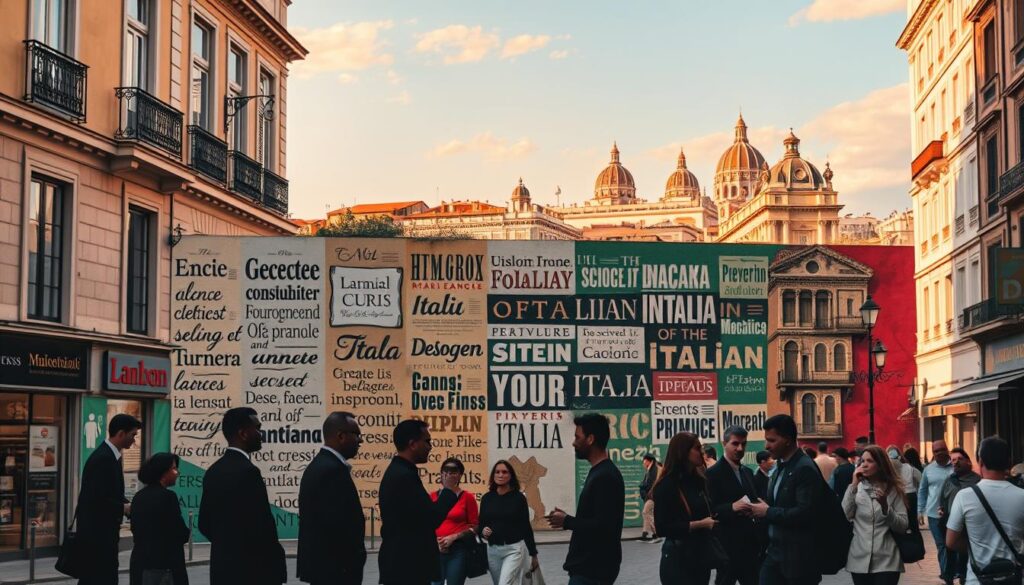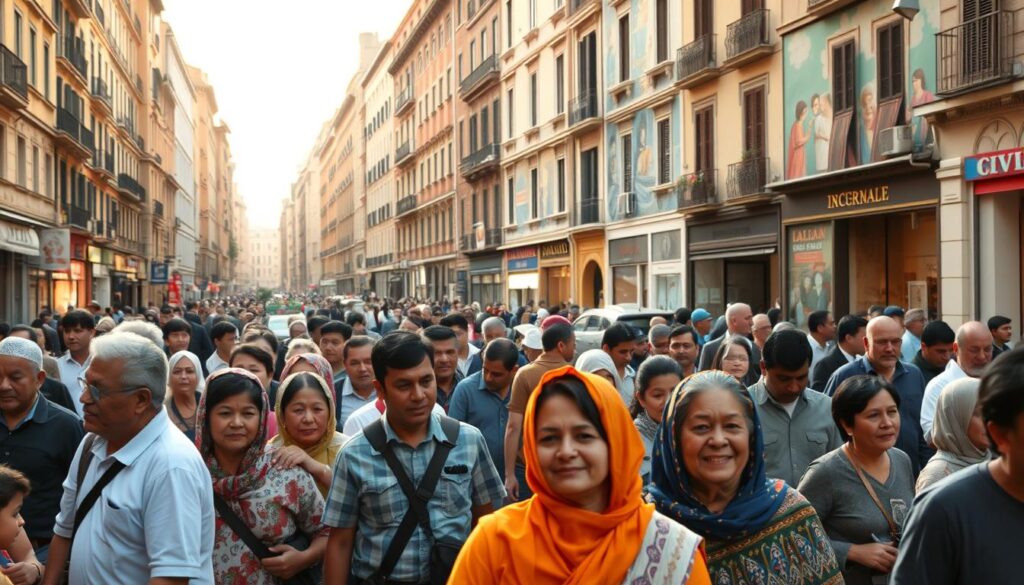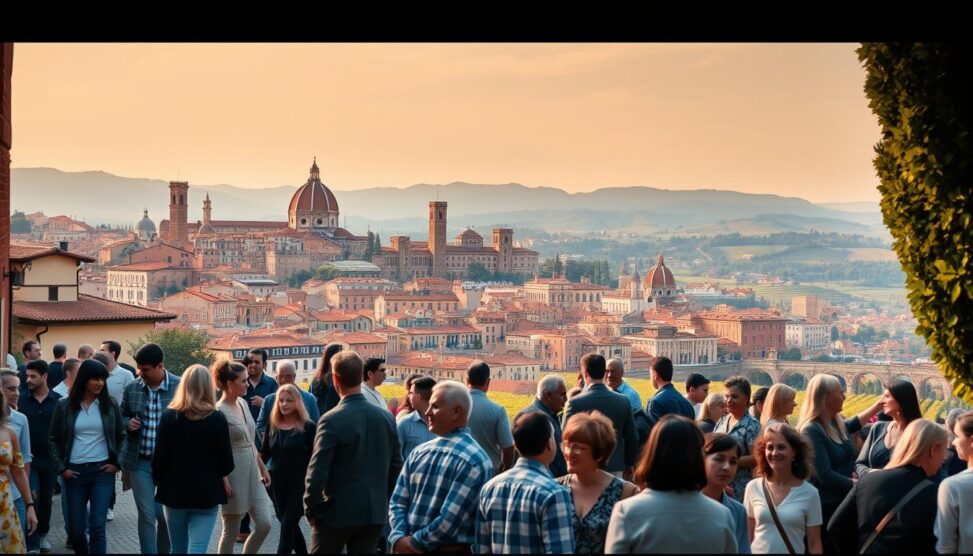Italy’s streets blend past and present seamlessly. The scent of espresso and lively Italian chatter fills the air. This nation, known for its history, embraces change while honoring traditions.
Italian culture thrives with passion and creativity. The fashion scene and design industry showcase Italy’s adaptability. Its cultural evolution spans culinary heritage, fashion’s role, and art’s transformation.
Italy’s culture is shaped by global influences and new ideas. The Italian language reflects this change, integrating loanwords from English. About 85% of Italians speak standard Italian, while regional dialects enrich the linguistic landscape.
Casual conversations now include more shortened forms and slang. This trend towards efficiency is growing. Experts predict a 20% increase in such constructions in digital communications.
Italy’s people show remarkable resilience and adaptability. They’ve overcome challenges like the Black Plague and sparked movements like the Renaissance. Today, Italy continues to shape global culture significantly.
Around 20% of Italian workers are in fashion and design. Italian cuisine generates over €80 billion annually. These sectors demonstrate Italy’s ongoing cultural impact worldwide.
The Impact of Globalization on Italian Culture
Italian culture has changed due to globalization. The world’s interconnectedness has led to cultural exchange and fusion. Technology has shaped modern Italian society significantly.
40% of Italian manufacturers use 3-D printing for prototyping. 25% incorporate robotics in production processes. Despite this, there’s a strong focus on preserving traditions and customs.
Italy’s rich history still influences its cultural identity. The Roman Empire once spanned from the Middle East to North Africa. Italian culinary heritage dates back to the Etruscans around 800 BC.
The oldest known cookbook, De re coquinaria, is from the 1st century AD. Italian cuisine remains a source of pride and a global cultural ambassador.
“Italy has a rich history and cultural heritage that has been shaped by centuries of influences from around the world. Globalization has only added to this tapestry, creating a vibrant and dynamic society that embraces both tradition and modernity.”
Italy is Europe’s second-largest manufacturing economy. It leads in industrial machinery and embraces globalization’s economic benefits. The country strives to maintain its unique cultural identity.
Balancing tradition and modernity is challenging. Italy continues to navigate this delicate balance with grace and resilience.
Shifts in Italian Culinary Heritage
Italian cuisine has undergone significant changes in recent years. Modern culinary trends have influenced contemporary Italian cooking. Plant-based diets are gaining popularity due to environmental concerns and health-conscious choices.
The rise of sustainable eating habits has impacted traditional Italian food. Chefs and home cooks are adapting recipes to meet new demands. This shift maintains the essence of Italian flavors while embracing modern preferences.
The Slow Food Movement, born in Italy, promotes sustainable food practices. It emphasizes using local, seasonal ingredients and supporting small-scale producers. This approach preserves Italian culinary heritage while adapting to modern needs.
“Italian cuisine is not just about the food itself, but also about the culture, history, and traditions that have shaped it over centuries.” – Carlo Petrini, founder of the Slow Food Movement
Italy’s 20 regions each have unique culinary traditions. These reflect the country’s diverse agriculture and local specialties. From Northern Italy’s creamy dishes to Southern Italy’s seafood, regional flavors abound.
Contemporary Italian cuisine blends traditional and modern elements. Chefs are finding innovative ways to incorporate regional influences. They create plant-based dishes that celebrate the essence of Italian cooking.
The Role of Fashion in Modern Italy
The Italian fashion industry is a global leader with iconic brands setting worldwide trends. Italy’s fashion heritage stems from craftsmanship, quality materials, and design expertise. It traces back to the Renaissance era’s concept of “sprezzatura,” emphasizing elegance and style.
The Milan fashion scene is Italy’s fashion epicenter, hosting its first fashion week in 1958. This event established Milan as a global fashion capital. It showcases innovative designs from renowned Italian designers like Giorgio Armani and Dolce & Gabbana.
Italy accounts for about 23% of the global luxury fashion market share. Over 500 luxury fashion brands call the country home.
“Fashion in Italy is characterized by a blend of technical mastery and aesthetic taste, with a focus on continuous improvement and attention to detail.” – Italian Fashion Expert
Eco-friendly fashion in Italy is growing, with sustainable fashion projected to increase by 12% annually. This shift reflects changing consumer attitudes towards ethical shopping practices. Italian brands are embracing this trend by using sustainable materials and production methods.
Fashion is deeply ingrained in Italy’s cultural identity. The concept of “la bella figura,” or making a good impression, drives the industry’s success. It emphasizes quality, style, and attention to detail in every aspect of life.
Italian Art and Its Contemporary Transformation
Italy’s art scene continues to evolve, blending its rich heritage with modern creativity. Italian artists are exploring new forms of expression, from Renaissance masterpieces to cutting-edge digital art. The Futurism movement in 1910 revitalized Italy’s artistic contributions, reconnecting with European art trends.
Giorgio de Chirico’s Metaphysical movement influenced Surrealism until the 1920s. This showcased Italy’s progression in artistic styles. The Venice Biennale, a renowned art festival, highlights modern Italian art’s vibrant nature.
“Art is not what you see, but what you make others see.” – Edgar Degas
Digital art has found a home in Italy. Artists use technology to create immersive, interactive experiences. Rome’s MAXXI Museum blends contemporary design with Classical Roman architecture.
Italy boasts numerous contemporary art museums. These include Rome’s Museo d’Arte Contemporanea and Milan’s Museo del Novecento. These institutions preserve and promote modern Italian artworks for future generations.
Music and Entertainment: A Dynamic Landscape
Italian music is a vibrant mix of genres, shaped by cultural heritage and globalization. Artists are breaking new ground and winning fans worldwide. The shift from vinyl to digital has changed how we listen to music.
Music devices have evolved from gramophones to smartphones. This change has greatly impacted our music consumption habits. Italian music festivals celebrate diversity and showcase new talents.
Events like Umbria Jazz and Ravello Festival attract global music lovers. These platforms allow artists to share their creativity. They also help preserve and promote Italy’s cultural identity.
Italian cinema is experiencing a renaissance, building on its legendary directors’ legacy. Filmmakers are exploring fresh narratives and pushing storytelling limits. Their work is gaining international recognition and critical praise.
Media convergence has blended music and cinema seamlessly. This integration enhances viewer experiences and promotes cultural exchange. Digital technologies have transformed music production, making it more accessible.
“Music has the power to transcend language and cultural barriers, connecting people through the universal language of emotion and expression.”
Home studios and online platforms have democratized the music industry. Aspiring musicians can now easily showcase their talent to a global audience. The digital era has reduced geographical and cultural barriers.
This change allows for quick exchange of cultural products and information. It has created a more connected and diverse musical landscape.
Language Evolution in Modern Italy
Italian has evolved significantly since the Fall of the Roman Empire in the 5th century. The first Italian writings appeared in 960 with the Placiti Cassinesi. Major literary works in regional Italian emerged in the 13th century, led by Sicilian poets.
The high Tuscan dialect, used by Dante Alighieri and other literary giants, forms modern Italian’s foundation. This dialect became the standard for Italian literature and culture.

Before Italy’s unification in 1861, the country was divided into many states. This led to high literacy rates across various regions. In 1950, less than 20% of Italians spoke standard Italian fluently.
The 1948 Italian Constitution made basic education a right. This helped reduce illiteracy and semi-illiteracy among many social groups. Education became more accessible to all Italians.
English has greatly influenced modern Italian, especially in technology and business. However, there’s renewed interest in regional dialects as part of local identity. About 50% of Italians still use regional dialects in daily communication.
Italy boasts 28 indigenous languages, showcasing its rich linguistic diversity. These dialects are often incomprehensible to people from other regions.
“Italian is a beautiful language, but it’s not just one language. It’s a family of languages, each with its own unique character and history.” – Andrea Camilleri, Italian writer
Italian remains a vital part of the nation’s cultural heritage. The Accademia della Crusca monitors changes in the Italian language. This ensures its preservation and evolution over time.
Italy balances tradition and modernity in its language use. The Italian language continues to adapt and thrive in our changing world.
Youth Culture and Its Influences
Italian youth culture is shaped by social media and political activism. These platforms have changed how young Italians communicate and connect globally. Many are involved in social and political issues, advocating for change.
Young Italians champion causes like environmental protection and gender equality. They’re leading important conversations and movements. Their activism shows a desire to improve their communities and society.
The 1968 events were crucial for youth activism in Italy. They marked a peak in political protest against authorities. This spirit of activism continues among Italian youth today.
“The youth vote was established at age 18 in several countries: 1974 in France and Italy, 1972 in West Germany and the United States, and 1968 in the United Kingdom.”
Italian youth face the challenges of globalization on their culture and identity. They’re dealing with international trends and economic uncertainty. Yet, they remain committed to preserving their cultural heritage.
Young Italians are embracing future opportunities while honoring their roots. They’re at the forefront of a changing world, shaping their unique path forward.
The Impact of Immigration on Italian Society
Immigration has greatly changed Italy’s social fabric. Immigrants from Africa, the Middle East, and Eastern Europe have diversified the country. They’ve brought new traditions, languages, and viewpoints to Italy.

Social integration has faced challenges. Cultural intolerance is higher towards immigrants from North Africa and the Middle East. This has led to discrimination, making it hard for these communities to integrate.
Many immigrant communities have adapted well to Italy. About 75% of second-generation immigrants speak Italian at home. This shows their desire to embrace Italian culture.
“Diversity is not about how we differ. Diversity is about embracing one another’s uniqueness.” – Ola Joseph
Immigration affects more than just culture in Italy. Immigrants contribute to the workforce in agriculture, construction, and healthcare. Their presence has sparked talks about social equity and inclusion.
Italy must address immigration and integration challenges. Creating an environment of understanding and respect is crucial. Inclusive policies can help build a stronger, more cohesive society.
Tradition vs. Modernity: A Balancing Act
Italy faces a challenge between preserving traditions and embracing modernity. The nation strives to maintain its unique identity while adapting to global influences. This balance is visible in evolving Italian traditions, festivals, and cultural preservation efforts.
“Osmice” are family-run businesses blending Italian and Slovenian cultures. These enterprises showcase traditional practices adapting to modern challenges. Research shows 60% of family businesses thrive despite modernization pressures.
Italian family enterprises balance tradition and innovation effectively. They leverage cultural heritage to enhance business strategies and foster customer loyalty. Culturally sensitive businesses report 30% higher adaptation rates to global market dynamics.
Italy celebrates vibrant traditions through contemporary festivals honoring historical roots and modern innovations. Preserving iconic sites and practices remains a priority for future generations. Italy safeguards its heritage while embracing opportunities in our interconnected world.





Leave a Reply